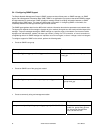
Chapter 6: Configuring IP
The Internet Protocol (IP) is a packet-based protocol used to exchange data over computer networks. All other IP
protocols are built on the foundation. IP is a network-layer protocol that contains addressing and control information
that allows data packets to be routed.
The table below lists the traditional classes and ranges of IP addresses and their status.
Class Address or Range Status
A 0.0.0.0
1.0.0.0 to 126.0.0.0
127.0.0.0
Reserved
Available
Reserved
B 128.0.0.0 to 191.0.0.0
255.255.255.0
Available
C 192.0.0.0 to
223.255.255.0
Available
D 224.0.0.0 to 239.255.255.255 Multicast group addresses
E 240.0.0.0 to 255.255.255.254
255.255.255.255
Reserved
Broadcast
With the rapid expansion of networks being connected to the Internet, critical problems were seen with the traditional
classified addressing scheme. It was possible that IP addresses would run out, and routing tables would be
overwhelmed. Thus, the Classless Inter-Domain Routing (CIDR) addressing scheme was created.
CIDR replaces the older process of assigning IP addresses with general prefixes of 8, 16, or 24 bits. CIDR uses
prefixes of 13 to 27 bits. A CIDR address includes the standard 32-bit IP address and adds information on how many
bits are used for the network prefix. In the IP address 206.203.1.35/27, the “/27” indicates that the first 27 bits are
used to identify the unique network, and the remaining bits are used to identify the specific host. Now, blocks of
addresses can be better fitted to even very small or very large networks.
The following table describes the Class C equivalent of CIDR prefixes.
CIDR Prefix Class C Equivalent Host Addresses
/27 1/8 Class C 32 Hosts
/26 1/4 Class C 64 Hosts
/25 1/2 Class C 128 Hosts
/24 1 Class C 256 Hosts
/23 2 Class C 512 Hosts
/22 4 Class C 1,024 Hosts
/21 8 Class C 2,048 Hosts
/20 16 Class C 4,096 Hosts
46 Asante IntraCore IC39240/480 User’s Manual


















